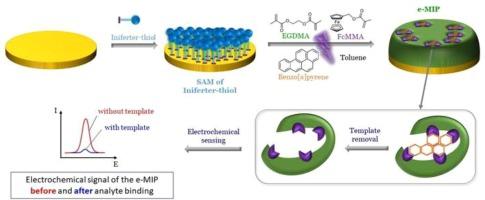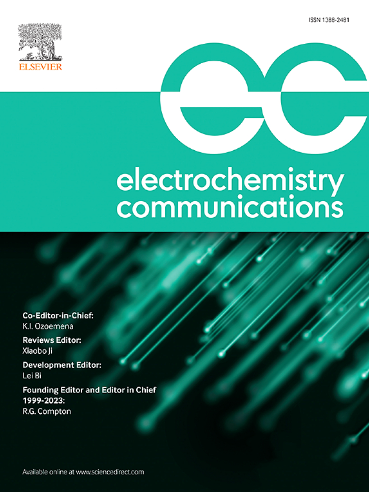Investigation of the modification of gold electrodes by electrochemical molecularly imprinted polymers as a selective layer for the trace level electroanalysis of PAH
IF 4.2
3区 工程技术
Q2 ELECTROCHEMISTRY
引用次数: 0
Abstract
Electrochemical molecularly imprinted polymers (e-MIPs) were grafted for the first time as a thin layer to the surface of a gold electrode to perform trace level electroanalysis of benzo(a)pyrene (BaP). This was achieved by controlled/living radical photopolymerization of a redox tracer monomer (ferrocenylmethyl methacrylate, FcMMA) with ethylene glycol dimethacrylate in the presence of benzo(a)pyrene as the template molecule. For that purpose, a novel photoiniferter-derived SAM was first deposited on the gold surface. The SAM formation was monitored by cyclic voltammetry and electrochemical impedance spectroscopy. Then, the “grafting from” of the e-MIP was achieved upon photoirradiation during a controlled time. Differential pulse voltammetry was used to quantify BaP in aqueous solution by following the modification of the signal of FcMMA. A limit of detection of 0.19 nM in water and a linear range of 0.66 nM to 4.30 nM, were determined, thus validating the enhancement of sensitivity induced by the close contact between the e-MIP and the electrode, and the improved transfer electron.

将电化学分子印迹聚合物修饰金电极作为多环芳烃痕量电分析选择层的研究
电化学分子印迹聚合物(e-MIPs)首次以薄层形式接枝到金电极表面,用于苯并(a)芘(BaP)的痕量电分析。这是通过氧化还原示踪单体(甲基丙烯酸二茂铁甲基酯,FcMMA)与乙二醇二甲基丙烯酸酯在苯并芘作为模板分子存在的情况下进行受控/活自由基光聚合实现的。为此,首先在金表面沉积了一种新型光增感剂衍生的 SAM。通过循环伏安法和电化学阻抗谱监测了 SAM 的形成。然后,在可控时间内进行光照射,实现 e-MIP 的 "接枝"。通过跟踪 FcMMA 信号的变化,使用差分脉冲伏安法对水溶液中的 BaP 进行定量。结果表明,在水中的检测限为 0.19 nM,线性范围为 0.66 nM 至 4.30 nM,从而验证了 e-MIP 与电极之间的紧密接触和电子转移的改进提高了灵敏度。
本文章由计算机程序翻译,如有差异,请以英文原文为准。
求助全文
约1分钟内获得全文
求助全文
来源期刊

Electrochemistry Communications
工程技术-电化学
CiteScore
8.50
自引率
3.70%
发文量
160
审稿时长
1.2 months
期刊介绍:
Electrochemistry Communications is an open access journal providing fast dissemination of short communications, full communications and mini reviews covering the whole field of electrochemistry which merit urgent publication. Short communications are limited to a maximum of 20,000 characters (including spaces) while full communications and mini reviews are limited to 25,000 characters (including spaces). Supplementary information is permitted for full communications and mini reviews but not for short communications. We aim to be the fastest journal in electrochemistry for these types of papers.
 求助内容:
求助内容: 应助结果提醒方式:
应助结果提醒方式:


